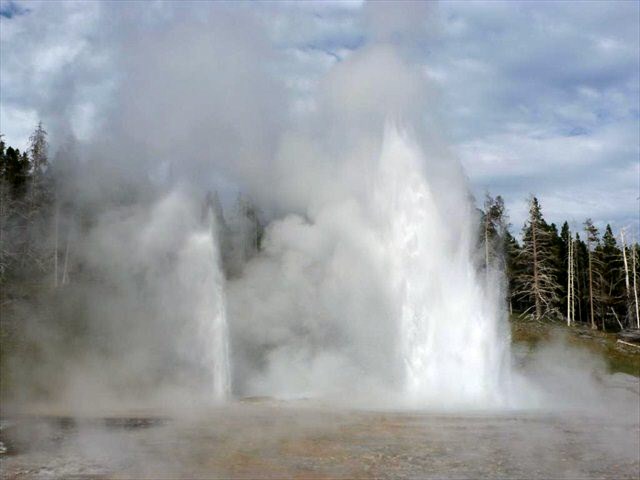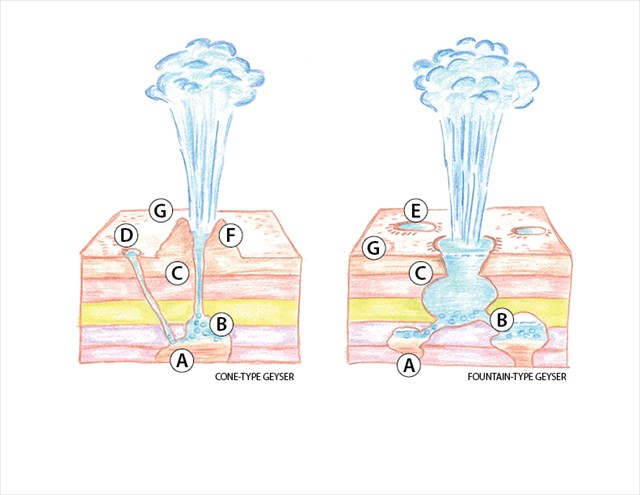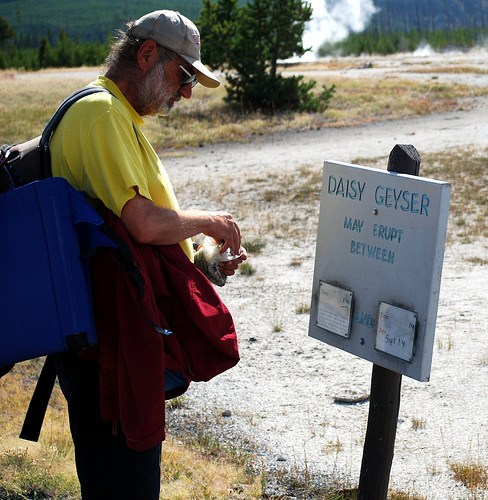
Welcome to Grand Geyser, the tallest predictable geyser in the world. It is difficult to witness the eruption of Grand Geyser because the interval between eruptions can be around 6 to 15 hours (the average has been about 7 to 8 hours for the past two years). But it has a magnificent display and its height can reach 180 feet. Grand Geyser is closely connected to the two smaller geysers in its immediate vicinity, Turban Geyser and Vent Geyser. If you meet a Geyser Gazer (explained on the cache page below), ask them when they think it will erupt and how they determine this and you'll start to understand the important science of predicting geyser eruptions. Timing is everything, so good luck and enjoy the show.
Logging requirements. In order to log this as a find you will need to make some observations of Grand Geyser and its surroundings and send us the answers to the following:
1. Look around the front edge of Grand Geyser's pool and you will notice some slightly raised sinter formations. At high water they form small islands or may even be covered by the water. How high do these formations stick out during low water?
2. Estimate the circumference of Grand Geyser vent and the two smaller geysers' vents next to it, Vent Geyser and Turban Geyser.
3. Estimate the distance from Grand Geyser's vent to Turban Geyser's vent and the distance from Grand Geyser's vent to Vent Geyser's vent.
4. As an option (and mega bonus points) post a photo of Grand Geyer's eruption and the time of the event and how long it lasted in your online log.
There are 2 types of geyers:
1. cone geysers such as Old Faithful, which erupt from cones or mounds of siliceous sinter (also known as geyserite), in steady jets. These blasts can last a few seconds to several minutes.
2. fountain geysers such as Grand Geyser, which erupt from pools of water, usually in a series of intense, even violent, bursts.
Geyser features:
The following features listed below are present between these two types of geysers. By observing the signs of activity in and around the geysers, you can start to learn how geyser gazers predict eruptions. Small jets of steam steadily increasing from vents and side channels or the rise and fall of water levels in pools or hot springs are just some of the signs to look for. As well, listen for increasing activity from vents and cones as the super-heated water and high pressure start to build up beneath the surface.
A. Super-heated water
B. High pressure from steam
C. Vent
D. Side channel
E. Hot springs
F. Sinter cone
G. Sinter deposits

What to look for:
Many people see the sign for Grand Geyser and then notice the large raised rim. This is in fact Turban Geyser. The large flat pool with almost no rim, on the right of Turban Geyser, is actually Grand Geyser. After an eruption from Grand this pool will empty and slowly start to fill again, reaching overflow in about 5 hours. Around this time Turban Geyser will start erupting about every 20 minutes for a few hours before the eruption of Grand Geyser. Turban’s eruptions will last about 5 minutes. Keep in mind that Grand Geyser can erupt within about one minute after Turban’s eruption. If it doesn’t then you’ll have to wait for Turban to erupt again before Grand has another chance to go off.
At the front edge of Grand Geyser’s pool, there are some smallish sinter formations. When the pool is at high level these formations will form small islands or will be completely covered by water. If the water remains high when Turban is expected to erupt, then look for big ripples on the pool. If there are ripples and the pool is still full there’s a very good chance of an eruption from Grand Geyser.
During Grand’s eruption, Turban’s eruptions will continue and increase in size from 5-10 feet to almost 20 feet. At this point Vent Geyser will also start to erupt. These two geysers will continue to erupt for about another hour, after Grand Geyser stops. Grand’s eruption can be spectacular and may even be more than one burst (continuous eruption of water) especially if the first burst is less than 10 minutes long. There can usually be anywhere from 2 to 4 bursts during Grand’s eruption. After a burst, check the water in the pool around Grand. It may be empty or if you’re lucky enough, you might start to see it rise and bubble. If it does, then an amazing full height burst, in one continuous motion, is eminent.
Geyser Gazing
As you walk around the Upper Basin (especially in the busier summer months) you may notice many people who look like they are prepared to spend the entire day in the area carrying 2-way radios and ample sun protection. They station themselves at geysers, observing and watching. And as soon as a geyser starts erupting, their radios became alive with chatter. These people are the Geyser Gazers. They are a community of knowledgeable geyser watchers who come to Yellowstone to watch the geysers and keep record of the eruptions. Some of these geyser gazers have been coming here for decades. Some come with their children, and even with their grand-children. They are very easy to talk to and will share a lot of their knowledge about predicting eruptions. You can learn a lot from them about the ‘events’ that will take place around a particular geyser and when it might erupt. Their knowledge and ability to predict eruptions are very significant for scientific study. After just a little time talking with them, you might see geysers in a much more exciting way.

**Please remember to stay on designated paths only. This earthcache was placed with permission from Yellowstone N.P.